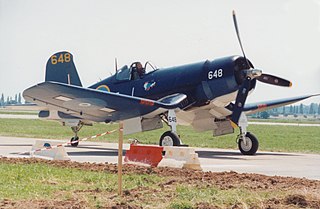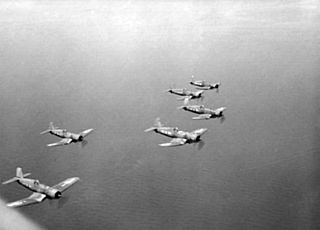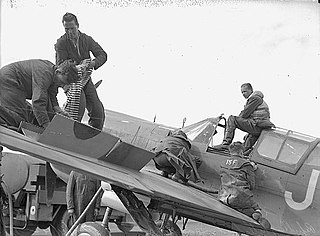
The Lockheed Ventura is a twin-engine medium bomber and patrol bomber of World War II.

Number 2 Squadron, also known as No. II Squadron, is the most senior squadron of the Royal Air Force. It is currently equipped with the Eurofighter Typhoon FGR4 at RAF Lossiemouth, Moray, since reforming there on 12 January 2015.

No. 2 Squadron RNZAF was a squadron of the Royal New Zealand Air Force (RNZAF). It was formed in 1930 as part of the Territorial Air Force with the main headquarters at Wellington and shadow flights at New Plymouth and Wanganui. Squadron personnel conducted their annual flying at RNZAF Base Wigram. In 1937 the Territorial Squadrons were re-organised and No. 2 Squadron became the Wellington Territorial Squadron.

14 Squadron RNZAF is a squadron of the Royal New Zealand Air Force. In 2015 the squadron was re-raised and equipped with 11 Beechcraft T-6 Texan II. A new aerobatic display team called the Black Falcons was also formed using the new aircraft. They replaced the RNZAF display team known as the Red Checkers.
No. 75 Squadron was a unit of the Royal Flying Corps and Royal Air Force in World War I and the RAF in World War II. In 1940–1945, it was a bomber unit comprised mainly of New Zealand-born personnel. In October 1945, the squadron number – along with its heraldry and honours – was relinquished by the RAF and transferred to the Royal New Zealand Air Force, officially becoming No. 75 Squadron RNZAF. No other RAF squadron has been gifted in this way, to another Commonwealth air force.

No. 486 (NZ) Squadron was a fighter squadron established for service during the Second World War. It was a New Zealand squadron formed under Article XV of the Empire Air Training Plan. Although many of its flying personnel were largely drawn from the Royal New Zealand Air Force, the squadron served in Europe under the operational and administrative command of the Royal Air Force.

No. 488 Squadron was the name given to two distinct Royal New Zealand Air Force squadrons during the Second World War. Both were formed under Article XV of the Empire Air Training Scheme and served under the operational command of the Royal Air Force.

No. 489 (NZ) Squadron was a torpedo bomber squadron established for service during the Second World War. It was a New Zealand squadron formed under Article XV of the Empire Air Training Plan. Although its flying personnel were largely drawn from the Royal New Zealand Air Force, the squadron served in Europe under the operational and administrative command of the Royal Air Force as part of Coastal Command.

No. 6 Squadron RNZAF is a maritime squadron of the Royal New Zealand Air Force. It has a history going back to World War II, when it operated flying boats, and has been disbanded and re-formed several times through changes in the country's military structure. The squadron motto, originally "Fortitudine et Diligentia", is now “Vigilance with Patience”.

No. 1 Squadron RNZAF was a New Zealand reconnaissance and patrol bomber squadron operating in the Pacific Theatre during World War II. After the war the squadron served in the transport and VIP role.
AirSols was a combined, joint command of Allied air units in the Solomon Islands campaign of World War II, from April 1943 to June 1944. It was subordinate to the Allied but U.S.-led Commander, South Pacific Area, itself part of Pacific Ocean Areas. AirSols superseded and absorbed the Cactus Air Force, which controlled Allied air units in the Solomons during 1942–43. AirSols was made up of United States Navy (USN), United States Marine Corps (USMC), the Royal New Zealand Air Force (RNZAF) and the Thirteenth Air Force, United States Army Air Forces (USAAF) forces.
No. 4 Squadron RNZAF was a Royal New Zealand Air Force (RNZAF) patrol bomber unit that served in the South Pacific during World War II.
No. 9 Squadron RNZAF was a New Zealand bomber reconnaissance squadron in the Pacific Theatre of World War II.
No. 268 Squadron RAF was a Royal Air Force squadron raised during the First World War and in the Second World War operated the North American P-51 Mustang on tactical reconnaissance missions over occupied Europe and in support of the D-Day landings.

No. 22 Squadron RNZAF was a squadron of the Royal New Zealand Air Force. Formed in August 1942, during World War II, at RNZAF Station Onerahi equipped with the Hawker Hind, co-ordinating with New Zealand Army units providing training for air liaison officers. Reformed on 19 June 1944 at RNZAF Station Ardmore, equipped with Chance-Vought F4U-1 Corsair fighter bombers. The squadron served at airfields in Espiritu Santo, Guadalcanal, Bougainville and Emirau before being disbanded in September 1945.
No. 6 Squadron was a Royal Canadian Air Force squadron that was active during the Second World War.

No. 18 Squadron was a squadron of the Royal New Zealand Air Force. Formed in June 1943 at RNZAF Base Woodbourne, the squadron was initially equipped with Curtiss P-40 Kittyhawks, before converting to F4U-1 Corsair fighter bombers in 1944. The squadron fought in the Pacific theatre during World War II, flying combat operations against Japanese forces until it was disbanded in late 1945.

765 Naval Air Squadron was a Naval Air Squadron of the Royal Navy's Fleet Air Arm. It formed at RNAS Lee-on-Solent, in May 1939, as a Seaplane School and Pool squadron. The squadron moved to RNAS Sandbanks, in August 1940, where it undertook the Seaplane Flying Training Course Part I. Lieutenant Commander J.B. Wilson was appointed as dual officer in charge of the air base, and Commanding officer of 765 NAS. By the middle of 1943, dedicated Seaplane Training schools ended and the squadron disbanded in the October. 765 NAS reformed at RNAS Charlton Horethorne, in early February 1944, as a Travelling Recording Unit. The squadron moved to RNAS Lee-on-Solent in March, before moving to RNAS Worthy Down on one month later during April, then in May it moved to RNAS Stretton, were it remained during June.

Percival Guy Haig Newton, was a flying ace of the Royal New Zealand Air Force (RNZAF) during the Second World War. He was credited with the destruction of at least five enemy aircraft.











